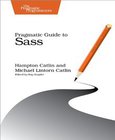Pragmatic Guide to JavaScript

Book Details:
| Publisher: | Pragmatic Bookshelf |
| Series: | Pragmatic Bookshelf |
| Author: | Christophe Porteneuve |
| Edition: | 1 |
| ISBN-10: | 1934356670 |
| ISBN-13: | 9781934356678 |
| Pages: | 160 |
| Published: | Dec 08 2010 |
| Posted: | Nov 19 2014 |
| Language: | English |
| Book format: | |
| Book size: | 4.55 MB |
Book Description:
Once the province of half-baked implementations and useless scrolling messages, JavaScript is now a powerful, dynamic language with a rich ecosystem of professional-grade development tools, infrastructures, frameworks, and toolkits. Presented in bite-sized two-page tasks, these JavaScript tips help practitioners start quickly and save time-particularly through shrewd use of reusable code libraries.The JavaScript ecosystem can be tough to hack through, even for experienced programmers. There are so many extensive JavaScript reference books and competing libraries to choose from-Prototype, jQuery, MooTools, YUI, Dojo, ExtJS, and so on. Christophe Porteneuve is here to help: he gives you fundamentals, the most handy techniques, and the insider's best practices. If you're reasonably comfortable programming in any widely known language, you'll be able to jump into JavaScript in no time.Divided into six Parts, the book starts with JavaScript code patterns that are too often ignored by JavaScript coders. Part 2 presents several essential JavaScript tasks-DOM and CSS manipulations, plus event handling and timers-in a framework-agnostic way, using syntax from all the major flavors. Parts 3 and 4, respectively, hit JavaScript's best features for user interface functionality-tooltips, lightboxes, image processing, infinite scrolling, and more-and forms for receiving and validating input. Part 5 explores the client/server relationship, touching on cookies, JSON, and Ajax (same- and cross-domain). Part 6 uses JavaScript in mashups with Twitter, Flickr, and geo-related APIs.The appendices feature Christophe's two-page JavaScript cheat sheet, followed by hard-won tips on debugging even the most maddening JavaScript errors. Next is an even-handed assessment of the major frameworks used in the book and in most JavaScript shops today. Last, Christophe presents an extensive group of resources for using and learning JavaScript and the major frameworks.This Pragmatic Guide is strictly focused on the techniques that will get you started in JavaScript. It's where you come to get the full scope of JavaScript in your head--fast! You'll quickly understand its core syntax, capabilities, and related frameworks. Start here first.
Download Link:
Related Books:
Pragmatic Guide to Sass
CSS is fundamental to the web, but it's a basic language and lacks many features. Sass is just like CSS, but with a whole lot of extra power so you can get more done, more quickly. Build better web pages today with Pragmatic Guide to Sass. These concise, easy-to-digest tips and techniques are the shortcuts experienced CSS developers need to start developing in Sass today. Written by Sass creator Hampton Catlin and Michael Lintorn Catlin, Pragmatic Guide to Sass shows you how to you to improve your CSS, from the basics to advanced topics, from first installation to sprucing up your buttons. You'll see how to code the right way in Sass thanks to short, clear examples. Two-page spreads show the explanation on one side and code examples on the other. You...
Pragmatic Guide to Git
Need to learn how to wrap your head around Git, but don't need a lot of hand holding? Grab this book if you're new to Git, not to the world of programming. Git tasks displayed on two-page spreads provide all the context you need, without the extra fluff.Get up to speed on Git right now with Pragmatic Guide to Git. Task-oriented two-page spreads get you up and running with minimal fuss. Each left-hand page dives into the underlying implementation for each task. The right-hand page contains commands that focus on the task at hand, and cross references to other tasks that are related. You'll find what you need fast.Git is rapidly becoming the de-facto standard for the open source community. Its excellent merging capabilities, coupled with its speed and ...
Securing Cloud Services
A pragmatic guide to security architecture in the Cloud
Cloud services, such as SalesForce, Amazon Web Services and Microsoft Azure, offer enterprise grade computing power to businesses of all sizes, without them having to invest in the hardware, software and staff usually needed to support equivalent on-premise services. Cloud Computing represents a major change to the IT services landscape, but it also introduces a different set of potential security risks, which need to be understood and addressed. Securing Cloud Services - A pragmatic approach to security architecture in the Cloud goes beyond the subject of generic Cloud security and, instead, offers a more detailed, architectural approach to securing Cloud services. It describes how security architecture processes may be used to derive a set of secur...
2007 - 2021 © eBooks-IT.org



